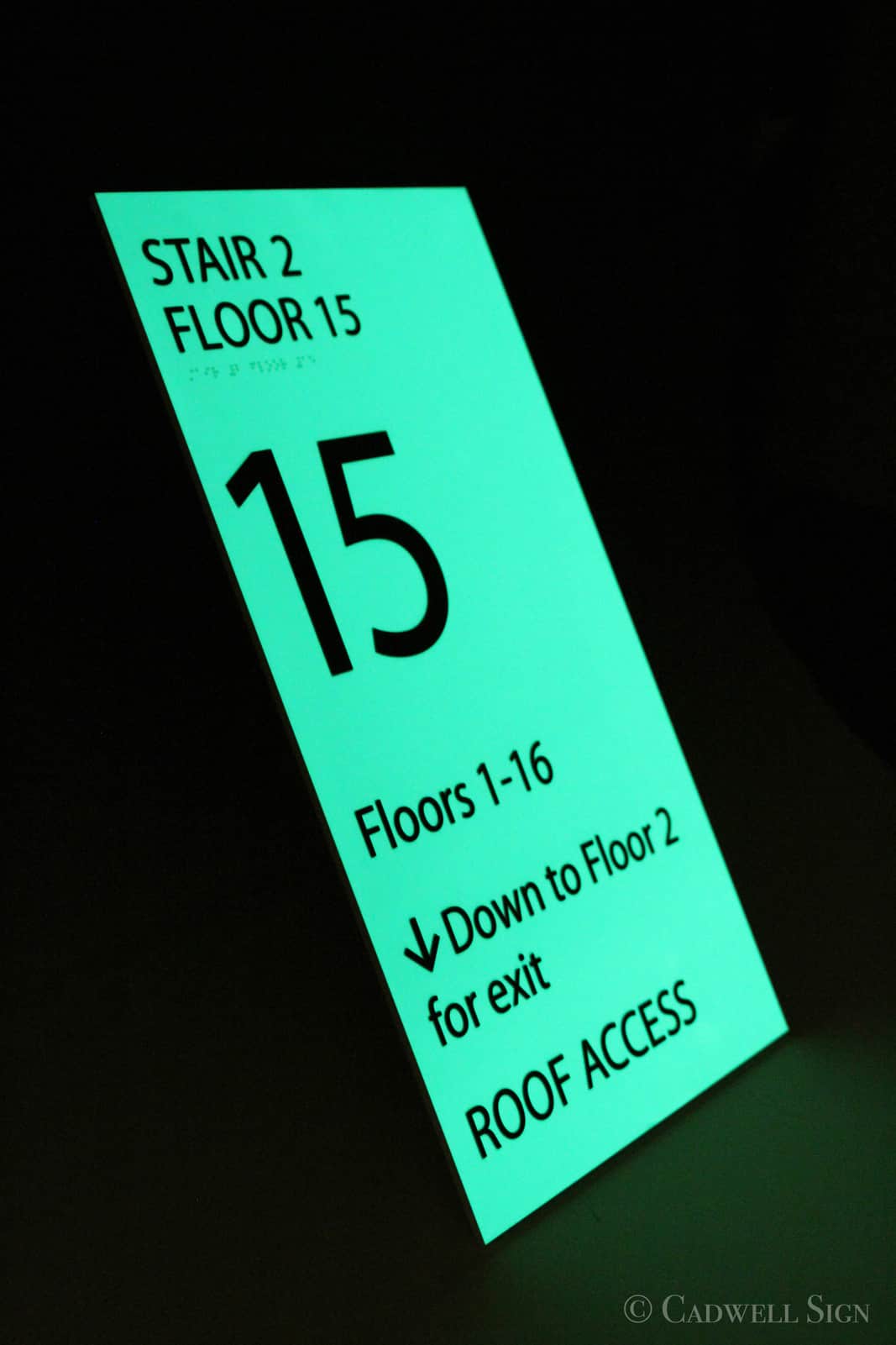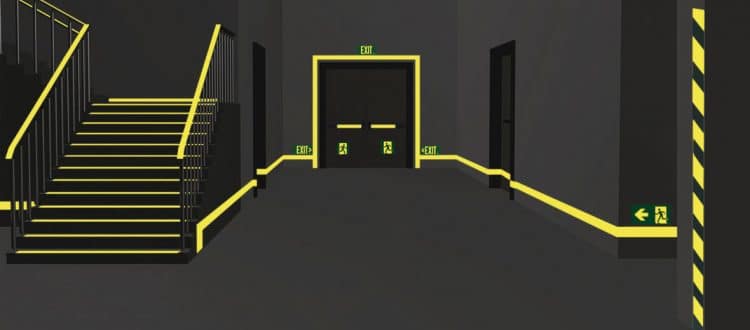Can You See in the Dark?
I want you to try something. But first, have someone with you: I don’t want you to be injured.
Go to the innermost area of your business. Turn out the lights. Close any blinds or window coverings. Now close your eyes and try to get to the nearest exit. How long did it take? How many times did you bump into something?
Now go to the top floor of the nearest multi-story building—the taller the better. Find a stairwell. Close your eyes again. And find your way down the stairs and outside. How did you do?
Now imagine having to do that in a place you’ve never been when the power is out, the stairwell is dark and smoky, and half the people around you are panicking, pushing and shoving.
The point here is that being able to find a safe escape route from a building is critical to the safety of employees, visitors and customers. Yet the quickest and most direct ways out of most buildings are not always clearly marked, even though markings that show an escape route can be a life or death matter.
According to Marina Batzke, general manager at American Permalight, photo-luminescent exit path markings that were installed on emergency staircases in the World Trade Center in New York City helped save lives on September 11, 2001. In fact, a NIST (National Institute of Standards and Technology) interview with World Trade Center survivors found that a third of those in Tower 1 and 17 percent from Tower 2 said they were helped by the photo-luminescent markings in stairways. By 2009 this led to new requirements both in New York City and nationwide, with both the International Code Council (ICC) and the National Fire Protection Association (NFPA) putting the requirements for luminous egress pathway markings into their codes. These nationwide requirements are more stringent than the previous (and now outdated) New York City MEA (Material Equipment and Acceptance) requirements. “The UL-1994-Listing is much more stringent,” notes Ms. Batzke, who is on the UL1994-Standards Technical Panel responsible for the UL Standard detailed in the nationwide Building Code requirements.
Know the Code
 Building codes vary nationwide and come with specific compliance requirements. While most are hardly new, all emergency egress regs are getting increased attention from local and state building inspectors and fire code officials. For the full details, take a look at International Building Code (IBC) requirements in Section 1024 of the 2009 and 2012 IBC, and in Section 1025 of the 2015 IBC. The quick story is that luminous markings are imperative for all exit enclosures on steps, landings, and hand rails, safe movement areas, on any obstacles, and on doors in exit enclosures. This includes—but is not limited to—new construction and renovation six stories and taller, as well as hotels, motels, office buildings, and healthcare facilities (especially hospitals). Check and understand your state and local regulations to find what is required in your area.
Building codes vary nationwide and come with specific compliance requirements. While most are hardly new, all emergency egress regs are getting increased attention from local and state building inspectors and fire code officials. For the full details, take a look at International Building Code (IBC) requirements in Section 1024 of the 2009 and 2012 IBC, and in Section 1025 of the 2015 IBC. The quick story is that luminous markings are imperative for all exit enclosures on steps, landings, and hand rails, safe movement areas, on any obstacles, and on doors in exit enclosures. This includes—but is not limited to—new construction and renovation six stories and taller, as well as hotels, motels, office buildings, and healthcare facilities (especially hospitals). Check and understand your state and local regulations to find what is required in your area.
And the nuances are important. For instance, part of the photo-luminescent egress path marking requirements in high-rise building emergency staircases specifies photo-luminescent floor level identification signs of at least 12×18-inches. Most state building codes further require the floor number to be denoted with raised characters with Braille underneath. A few jurisdictions even require the entire staircase identification sign to use all raised text with Braille underneath.
This sounds like a job for photopolymer.
A Bright Opportunity
Your sign making business is already positioned to provide superior photo-luminescent markings for steps, doorways, handrails and more. To do that, though, you need products that satisfy local and state regulations. However, not all “glow-in-the-dark” options are created equal, and the old New York City MEA standard has been determined to not be bright enough. Remember, these markings are designed to help keep people alive in worst-case scenarios. Long-lasting bright photo-luminescence can save lives.
For you as a signage provider, photo-luminescent signs and markings are an ideal companion to other internal signage, including the photopolymer ADA-compliant signs you may already offer. Photo-luminescent solutions range from hand rail markings to metal strips for the leading edges of steps to high performance glow-in-the-dark signs that denote doorways and exits. The appropriate material depends on the application, and while there are no one-size-fits-all options, your business can easily identify and provide a complete range of solutions for any type of building.
Nova Polymers is your prime source for attractive, durable, bright, cost-effective, UL1994-Listed photo-luminescent photopolymer that addresses nationwide needs. Both NovAcryl 250 and NovAcryl 150 PermaGlow materials absorb natural or artificial ambient light during the day and provide photo-luminescent emergency guidance when the lights go out—like in a black-out or even a building fire. NovAcryl 150 or 250 simply store the light acquired and release it back when the lights go out, providing photoluminescence for up to 90 minutes. This helps ensure orderly egress by identifying emergency stairwells and exits, fire extinguishers and emergency aids.
So imagine how much easier it would be to find your way out of a darkened building if the floors and stairs and wall edges had photo-luminescent markings. Look at your local regulations and talk with your customers about having luminous photopolymer materials in place in their buildings. Call Nova Polymers to learn how you can help people see in the dark.
Thanks to American Permalight for technical assistance with this story.

